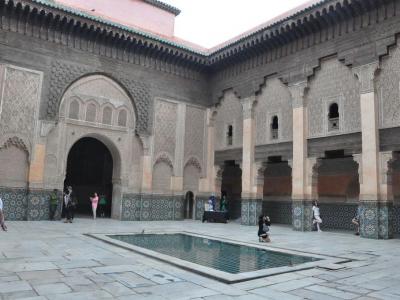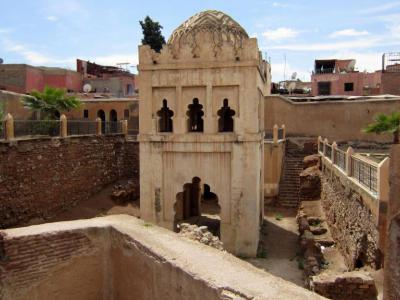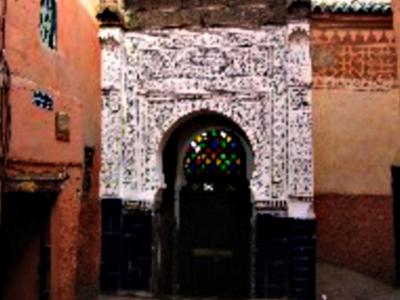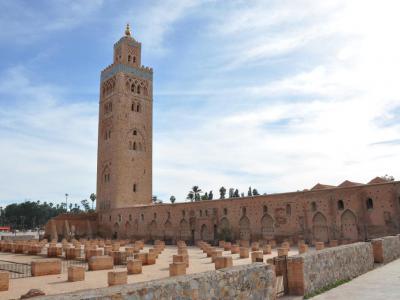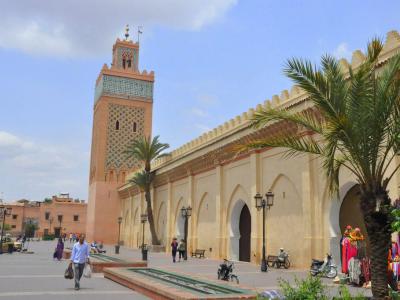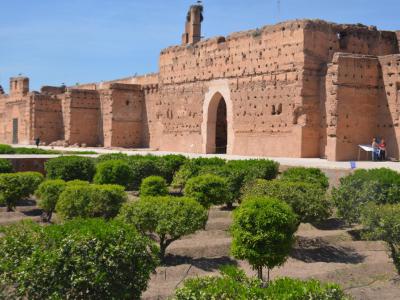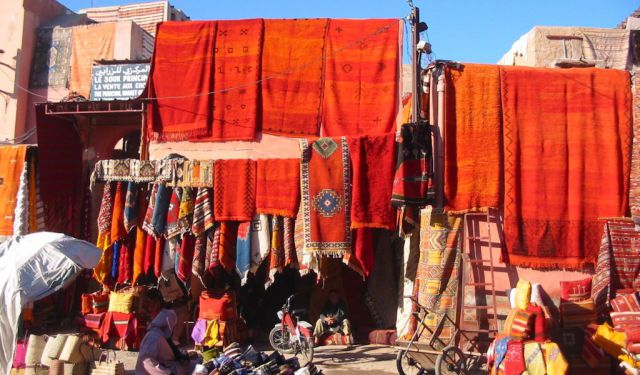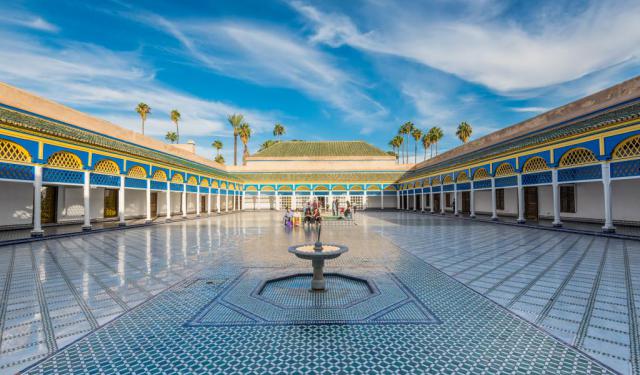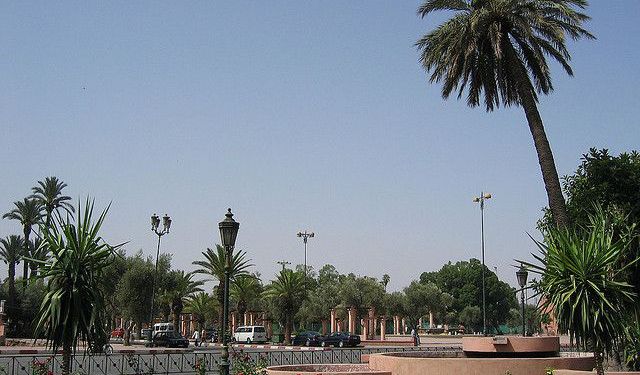Marrakech Top Religious Sites (Self Guided), Marrakech
Islam is the official religion in Morocco, which is why it is only natural that mosques are the dominant religious sites in the country, and Marrakech is no exception. Outside these places of worship, the city's religious scene is represented by unique historical monuments (koubbas), cemeteries, and mausoleums – all quite interesting to explore.
Our journey starts with the Ben Youssef Madrasa, an ancient Islamic school and a remarkable example of Moorish architecture. Visitors are captivated by its intricate stucco work, ornate tile patterns, and tranquil courtyard, providing a glimpse into Islamic education and aesthetics.
The nearby Almoravid Koubba showcases early Islamic architectural elegance. The 12th-century structure features a unique domed chamber with an ingeniously designed drainage system, offering insights into the city's historical water management.
The Mausoleum of Sidi Abd El Aziz is a revered site, honoring a prominent Sufi saint. It welcomes devotees and is open only to Muslims, but non-Muslims can still admire it from the outside.
The towering Koutoubia Mosque and its iconic minaret dominate Marrakech's skyline. While non-Muslims are not allowed in, its stunning architecture and beautifully landscaped gardens are a must-see.
The Kasbah Mosque, nestled in the historic Kasbah district, represents a significant spiritual center for locals. Its traditional Moroccan design and cultural significance make it a meaningful stop for visitors interested in the city's religious life.
Lastly, the Saadian Tombs, discovered in 1917, are a poignant reminder of Marrakech's yesteryear. The tombs house the remains of Saadian dynasty members and feature exquisite tilework, making them a unique blend of art and history.
To truly appreciate Marrakech's heritage, exploring these locations is highly recommended, as they can offer a glimpse into Morocco's religious tapestry. So, prepare yourself for a bit of Islam history lesson and robust architecture intake on this self-guided tour.
Our journey starts with the Ben Youssef Madrasa, an ancient Islamic school and a remarkable example of Moorish architecture. Visitors are captivated by its intricate stucco work, ornate tile patterns, and tranquil courtyard, providing a glimpse into Islamic education and aesthetics.
The nearby Almoravid Koubba showcases early Islamic architectural elegance. The 12th-century structure features a unique domed chamber with an ingeniously designed drainage system, offering insights into the city's historical water management.
The Mausoleum of Sidi Abd El Aziz is a revered site, honoring a prominent Sufi saint. It welcomes devotees and is open only to Muslims, but non-Muslims can still admire it from the outside.
The towering Koutoubia Mosque and its iconic minaret dominate Marrakech's skyline. While non-Muslims are not allowed in, its stunning architecture and beautifully landscaped gardens are a must-see.
The Kasbah Mosque, nestled in the historic Kasbah district, represents a significant spiritual center for locals. Its traditional Moroccan design and cultural significance make it a meaningful stop for visitors interested in the city's religious life.
Lastly, the Saadian Tombs, discovered in 1917, are a poignant reminder of Marrakech's yesteryear. The tombs house the remains of Saadian dynasty members and feature exquisite tilework, making them a unique blend of art and history.
To truly appreciate Marrakech's heritage, exploring these locations is highly recommended, as they can offer a glimpse into Morocco's religious tapestry. So, prepare yourself for a bit of Islam history lesson and robust architecture intake on this self-guided tour.
How it works: Download the app "GPSmyCity: Walks in 1K+ Cities" from Apple App Store or Google Play Store to your mobile phone or tablet. The app turns your mobile device into a personal tour guide and its built-in GPS navigation functions guide you from one tour stop to next. The app works offline, so no data plan is needed when traveling abroad.
Marrakech Top Religious Sites Map
Guide Name: Marrakech Top Religious Sites
Guide Location: Morocco » Marrakech (See other walking tours in Marrakech)
Guide Type: Self-guided Walking Tour (Sightseeing)
# of Attractions: 6
Tour Duration: 1 Hour(s)
Travel Distance: 2.7 Km or 1.7 Miles
Author: DanaOffice
Sight(s) Featured in This Guide:
Guide Location: Morocco » Marrakech (See other walking tours in Marrakech)
Guide Type: Self-guided Walking Tour (Sightseeing)
# of Attractions: 6
Tour Duration: 1 Hour(s)
Travel Distance: 2.7 Km or 1.7 Miles
Author: DanaOffice
Sight(s) Featured in This Guide:
- Ben Youssef Madrasa
- Almoravid Koubba
- Mausoleum of Sidi Abd El Aziz
- Koutoubia Mosque and Minaret
- Kasbah Mosque
- Saadian Tombs
1) Ben Youssef Madrasa (must see)
Ben Youssef Madrasa is one of Marrakech’s most celebrated historic monuments and one of the largest and finest Islamic colleges ever built in North Africa. Madrasa means “centre of learning” and can refer to a school, a college, or a university. Founded in the 14th century under the Marinid dynasty and later rebuilt in the mid-16th century by the Saadian sultans, the madrasa served for centuries as a centre of religious scholarship, attracting students from across Morocco and the wider Arab world. At its peak, it housed around 150 students, many of whom lived in tiny dormitory cells arranged around the upper floors.
After you walk through the entrance passage, you enter the central courtyard of the madrasa. Like most of Marrakech’s architectural gems, the vast courtyard is the heart of the complex, with all other parts radiating from it. The space is paved in marble, with a large reflecting pool that mirrors the surrounding ornamentation. Every surface seems carefully considered: walls covered in carved cedarwood, stucco panels etched with flowing Arabic calligraphy, and geometric tilework forming dazzling patterns. The beauty of the space was meant to inspire contemplation, discipline, and spiritual focus—qualities essential to the life of a Quranic scholar.
Equally striking is the contrast between the madrasa’s grand public spaces and its modest student quarters. The small, bare rooms offer a poignant reminder of the austere lives led by students who devoted themselves entirely to study. The rooms are arranged on two levels: the lower dormitory cells are accessible via doorways off the courtyard, while the upper ones can be reached by staircases located in the corners of the same courtyard.
Although the madrasa ceased operating as a school in the 1960s, it remains one of Marrakech’s cultural treasures. Its meticulous restoration allows visitors to appreciate the artistry of Saadian craftsmanship and the atmosphere of learning that once animated its halls. For anyone interested in Moroccan architecture, Islamic art, or the intellectual history of the Maghreb, Ben Youssef Madrasa offers an unforgettable window into the city’s past.
After you walk through the entrance passage, you enter the central courtyard of the madrasa. Like most of Marrakech’s architectural gems, the vast courtyard is the heart of the complex, with all other parts radiating from it. The space is paved in marble, with a large reflecting pool that mirrors the surrounding ornamentation. Every surface seems carefully considered: walls covered in carved cedarwood, stucco panels etched with flowing Arabic calligraphy, and geometric tilework forming dazzling patterns. The beauty of the space was meant to inspire contemplation, discipline, and spiritual focus—qualities essential to the life of a Quranic scholar.
Equally striking is the contrast between the madrasa’s grand public spaces and its modest student quarters. The small, bare rooms offer a poignant reminder of the austere lives led by students who devoted themselves entirely to study. The rooms are arranged on two levels: the lower dormitory cells are accessible via doorways off the courtyard, while the upper ones can be reached by staircases located in the corners of the same courtyard.
Although the madrasa ceased operating as a school in the 1960s, it remains one of Marrakech’s cultural treasures. Its meticulous restoration allows visitors to appreciate the artistry of Saadian craftsmanship and the atmosphere of learning that once animated its halls. For anyone interested in Moroccan architecture, Islamic art, or the intellectual history of the Maghreb, Ben Youssef Madrasa offers an unforgettable window into the city’s past.
2) Almoravid Koubba
The Almoravid Koubba is the only surviving structure from the Almoravid period in Marrakech, dating back to the early 12th century. Built around 1117 under the rule of Ali ibn Yusuf, the koubba once formed part of a larger religious and ablution complex attached to the nearby Ben Youssef Mosque. Its purpose was practical rather than ceremonial: it housed the water facilities where worshippers performed ablutions before prayer, fed by an advanced hydraulic system that showcased the Almoravids’ engineering skill.
Though modest in size, the building is architecturally significant. Its design blends influences from Andalusia, North Africa, and even older Abbasid styles, making it a valuable link in the evolution of Moroccan Islamic architecture. The structure sits partially below ground today because the level of the medina has risen over the centuries. Visitors enter the site by descending a few steps into an elegant, domed pavilion decorated with carved stucco, Kufic inscriptions, and intricate geometric motifs. The interior of the dome is particularly striking, featuring star-shaped openings and ribbed patterns that reveal the sophistication of 12th-century craftsmanship.
The Almoravid Koubba offers a rare glimpse into a chapter of Marrakech’s history that is otherwise largely invisible. Nearly all Almoravid architecture was altered or demolished by the succeeding Almohad dynasty, making this building a rare survivor. Standing within its cool, quiet chamber, you can imagine the rhythms of daily life nine centuries ago, when water, worship, and community converged at this small yet pivotal Almoravid masterpiece.
Though modest in size, the building is architecturally significant. Its design blends influences from Andalusia, North Africa, and even older Abbasid styles, making it a valuable link in the evolution of Moroccan Islamic architecture. The structure sits partially below ground today because the level of the medina has risen over the centuries. Visitors enter the site by descending a few steps into an elegant, domed pavilion decorated with carved stucco, Kufic inscriptions, and intricate geometric motifs. The interior of the dome is particularly striking, featuring star-shaped openings and ribbed patterns that reveal the sophistication of 12th-century craftsmanship.
The Almoravid Koubba offers a rare glimpse into a chapter of Marrakech’s history that is otherwise largely invisible. Nearly all Almoravid architecture was altered or demolished by the succeeding Almohad dynasty, making this building a rare survivor. Standing within its cool, quiet chamber, you can imagine the rhythms of daily life nine centuries ago, when water, worship, and community converged at this small yet pivotal Almoravid masterpiece.
3) Mausoleum of Sidi Abd El Aziz
With its wooden, carved eaves and horseshoe-shaped entrance, this Mausoleum, built in 1508 on the orders of the Alaouite Sultan and restored in 2019, is not open to non-Muslims, but don’t let that put you off going to admire it from the exterior, especially since it is on an interesting souk on the way to the mosque/medersa of Ben Youssef.
Sidi Abd el Aziz was a silk merchant in Fès who apparently underwent some kind of religious conversion and gave up his business to become a fervent follower and key disciple of Sidi ben Slimane, the founder of Moroccan Sufism. Thus, he moved to Marrakech were he preached Sufism ethics to craftsmen and corporations in the Ben Youssef Mosque.
Sufism's core dimensions are universal brotherhood, human values and spirituality. It believes in organic spread of faith, not conversion by the sword. It remains a pluralist, non-violent, and tolerant faith that gains adherents during times of conflict and “social decadence”; however, you'll find Sufis are persecuted in the more traditional fundamentalist societies.
Of course, in Islam there are no "saints", but Sidi Abd el Aziz, Sidi ben Slimane and five others are considered the “Seven Men” – equivalent to Christian saints – because they are all buried in Marrakech. The pilgrimage to their tombs, still being held in late March, was established in the 17th century in order to provide the city with extra religious significance.
Sidi Abd el Aziz was a silk merchant in Fès who apparently underwent some kind of religious conversion and gave up his business to become a fervent follower and key disciple of Sidi ben Slimane, the founder of Moroccan Sufism. Thus, he moved to Marrakech were he preached Sufism ethics to craftsmen and corporations in the Ben Youssef Mosque.
Sufism's core dimensions are universal brotherhood, human values and spirituality. It believes in organic spread of faith, not conversion by the sword. It remains a pluralist, non-violent, and tolerant faith that gains adherents during times of conflict and “social decadence”; however, you'll find Sufis are persecuted in the more traditional fundamentalist societies.
Of course, in Islam there are no "saints", but Sidi Abd el Aziz, Sidi ben Slimane and five others are considered the “Seven Men” – equivalent to Christian saints – because they are all buried in Marrakech. The pilgrimage to their tombs, still being held in late March, was established in the 17th century in order to provide the city with extra religious significance.
4) Koutoubia Mosque and Minaret (must see)
The Koutoubia Mosque and its soaring minaret are the most recognizable landmarks of Marrakech, standing at the edge of the bustling Jemaa el-Fnaa square and marking the spiritual heart of the city. Construction began in 1150, shortly after the Almohad dynasty seized Marrakech from the Almoravids. The mosque was built on the site of an earlier structure and later expanded, with its final form taking shape by the late 12th century. Its name, “Koutoubia,” comes from the Arabic term meaning “booksellers,” because it once stood beside a thriving market of manuscript vendors and scholars.
The minaret, rising approximately 77 meters including its spire, is a masterpiece of Almohad architecture and a model for later towers, including the Giralda in Seville and the Hassan Tower in Rabat. Built of red sandstone, it features harmonious proportions, decorative arches, and intricate geometric stonework, topped with a golden finial of four copper spheres. Its design reflects both the religious ambition and political authority of the Almohad empire, which sought to redefine Islamic architecture across North Africa and Al-Andalus.
The mosque itself is still in active use and not accessible to non-Muslims, but its exterior and surroundings offer much to appreciate. The gardens surrounding the mosque, known as the Koutoubia Gardens or Lalla Hasna Park, provide shaded paths, fountains, and views of the minaret framed by palms and roses. At sunset, when the tower glows softly against the sky and the call to prayer echoes across the city, the site becomes one of the most atmospheric places in Marrakech.
A Marrakech walking tour cannot be complete without its symbol. Wherever your legs take you, the Koutoubia Mosque is watching over you and is making sure that you will come back to take in the liveliness of its surroundings.
The minaret, rising approximately 77 meters including its spire, is a masterpiece of Almohad architecture and a model for later towers, including the Giralda in Seville and the Hassan Tower in Rabat. Built of red sandstone, it features harmonious proportions, decorative arches, and intricate geometric stonework, topped with a golden finial of four copper spheres. Its design reflects both the religious ambition and political authority of the Almohad empire, which sought to redefine Islamic architecture across North Africa and Al-Andalus.
The mosque itself is still in active use and not accessible to non-Muslims, but its exterior and surroundings offer much to appreciate. The gardens surrounding the mosque, known as the Koutoubia Gardens or Lalla Hasna Park, provide shaded paths, fountains, and views of the minaret framed by palms and roses. At sunset, when the tower glows softly against the sky and the call to prayer echoes across the city, the site becomes one of the most atmospheric places in Marrakech.
A Marrakech walking tour cannot be complete without its symbol. Wherever your legs take you, the Koutoubia Mosque is watching over you and is making sure that you will come back to take in the liveliness of its surroundings.
5) Kasbah Mosque
The Kasbah Mosque was built in the late 12th century, around 1185–1190, during the reign of Sultan Yaqub al-Mansur, the same ruler responsible for the iconic Koutoubia Mosque. Located within the royal kasbah — the fortified citadel that once served as the seat of power — the mosque was intended as the official place of worship for the sultan, his court, and the military elite. Its position near the Saadian Tombs underscores the sacred and ceremonial role of this district.
Although the mosque suffered damage from a massive explosion in the 16th century and later required reconstruction under the Saadians, it retains much of its original Almohad character. The minaret, built in a distinct style with decorative brickwork and subtle geometric motifs, stands as a quieter counterpart to the more famous Koutoubia. The prayer hall is supported by rows of arches and simple but elegant plasterwork, reflecting the Almohad preference for austere beauty rather than excessive ornamentation.
For visitors, the Kasbah Mosque is meaningful not only for its architecture but also for its context. It remains an active place of worship, offering a living connection to centuries of Moroccan religious life. While non-Muslims cannot enter the prayer hall, the exterior and surrounding neighborhood — including the nearby Saadian Tombs and the old kasbah walls — create a rich historical atmosphere.
Although the mosque suffered damage from a massive explosion in the 16th century and later required reconstruction under the Saadians, it retains much of its original Almohad character. The minaret, built in a distinct style with decorative brickwork and subtle geometric motifs, stands as a quieter counterpart to the more famous Koutoubia. The prayer hall is supported by rows of arches and simple but elegant plasterwork, reflecting the Almohad preference for austere beauty rather than excessive ornamentation.
For visitors, the Kasbah Mosque is meaningful not only for its architecture but also for its context. It remains an active place of worship, offering a living connection to centuries of Moroccan religious life. While non-Muslims cannot enter the prayer hall, the exterior and surrounding neighborhood — including the nearby Saadian Tombs and the old kasbah walls — create a rich historical atmosphere.
6) Saadian Tombs (must see)
The Saadian Tombs date back to the late 16th century, during the reign of Sultan Ahmad al-Mansur, who ruled from 1578 to 1603. He ordered the creation of an elaborate mausoleum to house his own tomb, as well as those of his family and high-ranking officials. The Saadians were known for their appreciation of beauty and refinement, and the tombs reflect this through exquisite craftsmanship and architectural detail.
After the fall of the Saadian dynasty, their successors — the Alaouites — sealed off the tombs, hiding them from sight rather than destroying them. For more than two centuries, the site remained largely forgotten, preserved by neglect rather than intention. It wasn’t until 1917, when French aerial photography revealed their presence, that the tombs were rediscovered and opened to the public.
The complex of the Saadian Tombs is made up of two mausoleums. The larger and more significant one is located on the western end of the complex. It consists of three interconnecting rooms, with the Chamber of the Twelve Columns as the main attraction. From the outside, this chamber sits between the other two rooms. Once you step inside, you can easily recognize the space thanks to its twelve marble columns arranged in groups of three. Three principal tombs stand at the centre of the chamber, with the middle one belonging to Sultan al-Mansur himself. The beauty of the room cannot be overstated: it is a masterpiece of marble, calligraphy, plasterwork, and flowing geometric design.
When you step back outside, quiet garden pathways lead past dozens of lesser royal family members’ graves, many of them covered in beautiful mosaic tiles.
For anyone interested in history, architecture, or Morocco’s royal past, this is one of Marrakech’s most essential — and hauntingly beautiful — stops.
After the fall of the Saadian dynasty, their successors — the Alaouites — sealed off the tombs, hiding them from sight rather than destroying them. For more than two centuries, the site remained largely forgotten, preserved by neglect rather than intention. It wasn’t until 1917, when French aerial photography revealed their presence, that the tombs were rediscovered and opened to the public.
The complex of the Saadian Tombs is made up of two mausoleums. The larger and more significant one is located on the western end of the complex. It consists of three interconnecting rooms, with the Chamber of the Twelve Columns as the main attraction. From the outside, this chamber sits between the other two rooms. Once you step inside, you can easily recognize the space thanks to its twelve marble columns arranged in groups of three. Three principal tombs stand at the centre of the chamber, with the middle one belonging to Sultan al-Mansur himself. The beauty of the room cannot be overstated: it is a masterpiece of marble, calligraphy, plasterwork, and flowing geometric design.
When you step back outside, quiet garden pathways lead past dozens of lesser royal family members’ graves, many of them covered in beautiful mosaic tiles.
For anyone interested in history, architecture, or Morocco’s royal past, this is one of Marrakech’s most essential — and hauntingly beautiful — stops.
Walking Tours in Marrakech, Morocco
Create Your Own Walk in Marrakech
Creating your own self-guided walk in Marrakech is easy and fun. Choose the city attractions that you want to see and a walk route map will be created just for you. You can even set your hotel as the start point of the walk.
Marrakech Shopping Tour
Shopping in Marrakech is an extraordinary experience that captivates the senses. Perhaps no other shopping in your life will compare to it: vivid, bright, juicy colors of carpets, clothes, and shoes; enchanting smells of local perfumes and spices; crafts, handmade jewelry, pottery; and of course, the long shopping mazes and souks.
One of the most iconic shopping destinations in Marrakech is... view more
Tour Duration: 1 Hour(s)
Travel Distance: 1.0 Km or 0.6 Miles
One of the most iconic shopping destinations in Marrakech is... view more
Tour Duration: 1 Hour(s)
Travel Distance: 1.0 Km or 0.6 Miles
Moroccan Architecture Walking Tour
No tall skyscrapers, no sophisticated giant malls, no anything else of Western architecture await you on this tour. Our self-guided walk is entirely about the genuine Moroccan style. We are going to reveal Marrakech which will amaze you with its majestic structures, traditional motifs, and mystic atmosphere.
Our first stop is a prominent example of Islamic architecture, the Koutoubia Mosque.... view more
Tour Duration: 3 Hour(s)
Travel Distance: 4.6 Km or 2.9 Miles
Our first stop is a prominent example of Islamic architecture, the Koutoubia Mosque.... view more
Tour Duration: 3 Hour(s)
Travel Distance: 4.6 Km or 2.9 Miles
Medina Walking Tour
“Here everything is red — the walls, the earth, the dust that rises at every step.” French novelist and naval officer Pierre Loti was visibly impressed by the medina's choice of color. Who is there to say that Loti's visit in the 19th century did not foreshadow the French Protectorate two decades later?
The medina of Marrakech, today one of the most recognisable historic... view more
Tour Duration: 1 Hour(s)
Travel Distance: 1.9 Km or 1.2 Miles
The medina of Marrakech, today one of the most recognisable historic... view more
Tour Duration: 1 Hour(s)
Travel Distance: 1.9 Km or 1.2 Miles
Moroccan Palaces Walking Tour
One of the meaningful ways to pass the time away in Marrakech is to visit the local palaces. This is particularly true given that some of them, now restored and refurbished, function as museums. Others, on the other hand, are slowly turning into ruins, which is sad. Nonetheless, they all have a long story to tell and spectacular architecture fit to amaze any beholder.
Among the most renowned... view more
Tour Duration: 1 Hour(s)
Travel Distance: 2.7 Km or 1.7 Miles
Among the most renowned... view more
Tour Duration: 1 Hour(s)
Travel Distance: 2.7 Km or 1.7 Miles
Gueliz Walking Tour
Gueliz, also known as the New City (Nouvelle Ville), is more like the downtown of Marrakech. Here you will definitely feel the Western influence: McDonald's, KFC, brand stores, and even a supermarket. Still, Gueliz is also famous for its art galleries and parks.
We'll start our acquaintance with Gueliz in the El-Harti Gardens (Jnane El Harti), a peaceful oasis amidst the bustling... view more
Tour Duration: 2 Hour(s)
Travel Distance: 3.1 Km or 1.9 Miles
We'll start our acquaintance with Gueliz in the El-Harti Gardens (Jnane El Harti), a peaceful oasis amidst the bustling... view more
Tour Duration: 2 Hour(s)
Travel Distance: 3.1 Km or 1.9 Miles
Marrakech Introduction Walking Tour
“The sunset over Marrakech is like nothing else in the world.” Winston Churchill clearly could not hide his admiration for the city. The proof lies in the more than fifty trips he made throughout his life, many of them marked by his paintings of Marrakech—especially of that glowing, unforgettable sunset.
Marrakech was founded in 1070 by the Almoravids, a Berber dynasty that transformed a... view more
Tour Duration: 2 Hour(s)
Travel Distance: 3.9 Km or 2.4 Miles
Marrakech was founded in 1070 by the Almoravids, a Berber dynasty that transformed a... view more
Tour Duration: 2 Hour(s)
Travel Distance: 3.9 Km or 2.4 Miles
The Most Popular Cities
/ view all



